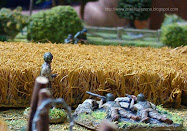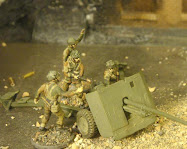The
German plan for what became known as the September Campaign was devised by General
Franz Halder,
chief of the general staff, and directed by General
Walther von Brauchitsch, the
commander in chief of the upcoming campaign. It called for the start of hostilities before a
declaration of war, and pursued a doctrine of mass encirclement and destruction of enemy forces. The infantry – far from completely mechanized but fitted with fast moving artillery and logistic support – was to be supported by
German tanks and small numbers of truck-mounted infantry (the Schützen regiments, forerunners of the
panzergrenadiers) to assist the rapid movement of troops and concentrate on
localized parts of the enemy
front, eventually isolating segments of the enemy, surrounding, and destroying them. The pre-war armored idea (which an American journalist in 1939 dubbed
Blitzkrieg), which was advocated by some generals, including
Heinz Guderian, would have had the armor punching holes in the enemy's front and ranging deep into rear areas, but in actuality, the campaign in Poland would be fought along more traditional lines. This stemmed from conservatism on the part of the German high command, who mainly restricted the role of armor and mechanized forces to supporting the conventional infantry divisions.
Poland's terrain was well suited for mobile operations when the weather cooperated – the country had flat
plains with long frontiers totalling almost 5,600 kilometres (3,500 mi), Poland's long border with Germany on the west and north (facing
East Prussia) extended 2,000 kilometres (1,250 mi). Those had been lengthened by another 300 kilometres (180 mi) on the southern side in the aftermath of the Munich Agreement of 1938; the German incorporation of
Bohemia and Moravia and creation of the German
puppet state of
Slovakia meant that Poland's southern flank was exposed.
German planners intended to fully exploit their long border with the great enveloping manoeuvre of Fall Weiss. German units were to invade Poland from three directions:
A main attack over the western Polish border. This was to be carried out by Army Group South commanded by General
Gerd von Rundstedt, attacking from German
Silesia and from the
Moravian and Slovak border: General
Johannes Blaskowitz's 8th Army was to drive eastward against
Łódź; General
Wilhelm List's 14th Army was to push on toward
Kraków and to turn the Poles'
Carpathian flank; and General
Walter von Reichenau's 10th Army, in the centre with Army Group South's armour, was to deliver the decisive blow with a northeastward thrust into the heart of Poland.
A second route of attack from northern
Prussia. General
Fedor von Bock commanded Army Group North, comprising General
Georg von Küchler's 3rd Army, which was to strike southward from East Prussia, and General
Günther von Kluge's 4th Army, which was to attack eastward across the base of the
Polish Corridor.
A tertiary attack by part of Army Group South's allied
Slovak units from Slovakia.
From within Poland, the German minority would assist by engaging in diversion and sabotage operations through
Selbstschutz units prepared before the war.
All three assaults were to converge on
Warsaw, while the main Polish army was to be
encircled and destroyed west of the
Vistula. Fall Weiss was initiated on 1 September 1939, and was the first operation of the Second World War in Europe.
Following several German-staged incidents (
Operation Himmler), which German propaganda used as an excuse to claim that German forces were acting in
self-defense, the first regular act of war took place on 1 September 1939, at 04:40, when the German Air Force (Luftwaffe)
attacked the Polish town of Wieluń, destroying 75% of the city and killing close to 1,200 people, most of them civilians. Five minutes later, the old German
battleship Schleswig-Holstein opened fire on the Polish military transit depot at
Westerplatte in the
Free City of Danzig on the
Baltic Sea. At 08:00, German troops, still without a formal declaration of war issued,
attacked near the Polish town of Mokra. The
battle of the border had begun. Later that day, the Germans attacked on Poland's western, southern and northern borders, while German aircraft began raids on Polish cities. The main axes of attack led eastwards from Germany proper through the western Polish border. Supporting attacks came from
East Prussia in the north, and a co-operative German-
Slovak tertiary attack by units (Army "Bernolak") from German-allied
Slovakia in the south. All three assaults converged on the Polish capital of Warsaw.
The Allied governments declared war on Germany on 3 September; however, they
failed to provide any meaningful support. The German-French border saw only
a few minor skirmishes, although the majority of German forces, including eighty-five percent of their armoured forces, were engaged in Poland. Despite some Polish successes in minor border battles, German technical, operational and numerical superiority forced the Polish armies to retreat from the borders towards Warsaw and
Lwów. The Luftwaffe gained
air superiority early in the campaign. By destroying communications, the Luftwaffe increased the pace of the advance which overran Polish airstrips and early warning sites and causing logistical problems for the Poles. Many
Polish Air Force units ran low on supplies, 98 of their number withdrew into then-neutral
Romania.
[28] The Polish initial strength of 400 was reduced to just 54 by September 14 and air opposition virtually ceased.
[28]By September 3, when
Günther von Kluge in the north had reached the Vistula (some 10 kilometres from the German border at that time) river and
Georg von Küchler was approaching the
Narew River,
Walther von Reichenau's armour was already beyond the
Warta river; two days later, his left wing was well to the rear of
Łódź and his right wing at the town of
Kielce; and by September 8, one of his armoured corps was on the outskirts of Warsaw, having advanced 225 kilometres (140 miles) in the first week of war. Light divisions on Reichenau's right were on the
Vistula between Warsaw and the town of
Sandomierz by September 9, while List, in the south, was on the river
San above and below the town of
Przemyśl. At the same time, Guderian led his 3rd Army tanks across the Narew, attacking the line of the
Bug River, already encircling Warsaw. All the German armies made progress in fulfilling their parts of the Fall Weiss plan. The Polish armies were splitting up into uncoordinated fragments, some of which were retreating while others were launching disjointed attacks on the nearest German columns.
Polish forces abandoned regions of
Pomerania,
Greater Poland and
Silesia in the first week. The Polish plan for border defence was proven a dismal failure. The German advance as a whole was not slowed. On September 10, the Polish commander-in-chief, Marshal
Edward Rydz-Śmigły, ordered a
general retreat to the southeast, towards the so-called
Romanian bridgehead. Meanwhile, the Germans were tightening their encirclement of the Polish forces west of the Vistula (in the Łódź area and, still farther west, around
Poznań) and also penetrating deeply into eastern Poland. Warsaw, under heavy aerial bombardment since the first hours of the war, was attacked on September 9 and was
put under siege on September 13. Around that time, advanced German forces also reached the city of Lwów, a major
metropolis in eastern Poland. 1,150 German aircraft bombed Warsaw on September 24.
The largest battle during this campaign, the
Battle of Bzura, took place near the
Bzura river west of Warsaw and lasted from September 9 to September 19. Polish armies Poznań and Pomorze, retreating from the border area of the Polish Corridor, attacked the flank of the advancing German 8th Army, but the counterattack failed after initial success. After the defeat, Poland lost its ability to take the initiative and counterattack on a large scale. German air power was instrumental during the battle. The Luftwaffe's offensive broke what remained of Polish resistance in an "awesome demonstration of air power".
[29] The Luftwaffe quickly destroyed the bridges across the Bzura River. Afterward, the Polish forces were trapped out in the open, and were attacked by wave after wave of Stukas, dropping 50 kg 'light bombs' which caused huge numbers of casualties. The Polish flak positions ran out of ammunition and retreated to the forests, but were then 'smoked out' by the
Heinkel He 111 and
Dornier Do 17s dropping 100 kg incendiaries. The Luftwaffe left the army with the easy task of mopping up survivors. The Stukageschwaders alone dropped 388
tonnes of bombs during this battle.
[29]The Polish government (of President
Ignacy Mościcki) and the high command (of
Marshal Edward Rydz-Śmigły) left Warsaw in the first days of the campaign and headed southeast, reaching
Brześć on September 6. Rydz-Śmigły ordered the Polish forces to retreat in the same direction, behind the Vistula and San rivers, beginning the preparations for the long defence of the Romanian bridgehead area.
 En el norte las fuerzas republicanas han cedido al ataque de los ataques alemanes, la artillería así como la fuerza conjunta de los bombardeos nocturnos han diezmado a la infantería que si no se han replegado han sido abatidos por completo.
En el norte las fuerzas republicanas han cedido al ataque de los ataques alemanes, la artillería así como la fuerza conjunta de los bombardeos nocturnos han diezmado a la infantería que si no se han replegado han sido abatidos por completo.






























































